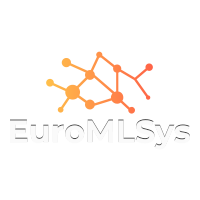The recent wave of research focusing on machine learning and artificial intelligence and its applications has been fuelled by both hardware improvements, ML Compilers and deep learning frameworks that simplify the design, training, inference of neural models. Over the past five years, EuroMLSys was held in conjunction with EuroSys (https://www.euromlsys.eu). The program included topics such as neural model and inference performance optimisation, and compilation for ML workloads. The past workshops were successful, with high quality papers and good size audiences.
This year’s workshop will provide a platform for discussing emerging trends in building frameworks, programming models, optimisation algorithms, and software engineering to support AI/ML applications. At the same time, using ML for building such frameworks or optimisation tools will be discussed. Recent emergence of LLM and agentic systems is remarked by their substantial computational requirements, and optimisation in every possible part of the system will be important. EuroMLSys aims to bridge the gap between AI research and practice, through a technical program of fresh ideas on software infrastructure, tools, design principles, and theory/algorithms, from a systems perspective. We will also explore potential applications that will take advantages of ML.
News
- The workshop website is up!
Key dates
- Paper submission deadline: February 15, 2026 (23:59 AoE)
- Acceptance notification: March 15, 2026
- Final paper due: March 25, 2026
- Workshop: April 27, 2026 (full-day workshop)
Past Editions
Call for Papers
A growing area of interest in machine intelligence is at the intersection of AI/ML and systems design. At the same time, applications of ML are growing in complexity and so is the volume of data they produce/consume. For computer systems to scale, new learning approaches and advanced optimisation techniques are needed. We also need to understand better the current AI/ML frameworks, in terms of their functionality, limitations, and target applications. This will clarify potential desired functions and future architectures. Novel machine learning methods to optimise and accelerate software and hardware systems must also be developed.
EuroMLSys is an interdisciplinary workshop that brings together researchers in computer architecture, systems and machine learning, along with practitioners who are active in these emerging areas.
Topics of interest include, but are not limited to, the following:
- Scheduling algorithms for data processing clusters
- Custom hardware for machine learning
- Programming languages for machine learning
- Benchmarking systems (for machine learning algorithms)
- Synthetic input data generation for training
- Systems for training and serving machine learning models at scale
- Graph neural networks
- Neural network compression and pruning in systems
- Large scale distributed learning algorithms in practice
- Database systems for large scale learning
- Systems for model-free and model-based Reinforcement Learning
- Optimisation in end-to-end deep learning
- System optimisation using Bayesian Optimisation
- Use of probabilistic models in ML/AI application
- Analysis of distributed ML algorithms
- Probabilistic modelling for distributed ML algorithms
- Synchronisation and state control of distributed ML algorithms
- ML Compiler Optimisation
- Optimisation in Large Language Model (LLM)
- Agentic Systems
Accepted papers will be published in the ACM Digital Library (you can opt out from this).
Committees
Workshop and TPC Chairs
- Eiko Yoneki, University of Cambridge, https://www.cl.cam.ac.uk/~ey204/
- Paul Patras, University of Edinburgh, http://homepages.inf.ed.ac.uk/ppatras/
Technical Program Committee
Coming soon...
Web Chair
- Alexis Duque, Net AI
Contact
For any question(s) related to EuroMLSys 2025, please contact the TPC Chairs Eiko Yoneki and Paul Patras.
 Follow us on Twitter: @euromlsys
Follow us on Twitter: @euromlsys
